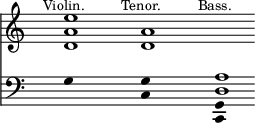formed on a different model from the Violone. It is traceable in Italy early in the 17th century, was at first used exclusively as a fundamental bass in the concerted music of the church, and it is not until a century later that it appears to have taken its place as a secular and solo instrument. Elsewhere during the 17th century and a considerable part of the 18th, the Viol Bass (Viola da gamba) was almost exclusively in use as a bass instrument. The first English violoncellos date from about the Restoration. The oldest one known to the writer is undoubtedly the work of Edward Pamphilon. It is of a very primitive pattern, being extremely bombé in the back and belly, the arching starting straight from the purfling, which is double. The writer has also seen a Violoncello by Rayman, another of the Restoration fiddlemakers. Barak Norman's Violoncellos are not uncommon, though far fewer than his innumerable Bass Viols. The earlier Violoncellos in England therefore date not long after those of Italy; the French and German ones somewhat later. The Violoncello must have been kept out of general use by its irrational fingering; for being tuned by fifths, and the fingers of the performer being only able to stretch a major third, the hand has great difficulty in commanding the scales: and it was not until the middle of the last century that its difficulties were sufficiently overcome to enable it to practically supplant the Viola da Gamba in the orchestra. [See Gamba, vol. i. p. 579.]
The adoption of four strings, tuned by fifths, for the Violin in its three sizes, really marks the emancipation of bowed instruments from the domination of the Lute. Such impediments to progress as complicated and various tunings, frets, and tablature music were thus removed. In most respects this change facilitated musical progress. The diminished number of strings favoured resonance; for in six-stringed instruments there is an excessive pressure on the bridge which checks vibration and increases resistance to the bow. By the change the fingering was simplified, though in the larger instruments it was rendered more laborious to the executant. Composers, though still obliged to regard the limited capacities of stringed instruments, were able to employ them with less reserve. Music, however, cannot be said to have lost nothing by the abandonment of the Viol.[1] The Violin affords fewer facilities for harmonic combinations and suspensions, in the form of chords and arpeggios. Bowed instruments tended more and more to become merely melodic, like wind instruments. Effect soon came to be sought by increasing the length of the scales, and employing the higher and less agreeable notes, the frequent use of which, as in modern music, would have shocked the ears of our forefathers. It is often supposed that early violinists were not sufficiently masters of their instrument to command the higher positions. Nothing can be more absurd. In addition to what has been stated under the head Shift, it may be observed that many existing compositions for the Viola da Gamba prove that very complicated music was played on that instrument across the strings in the higher positions, and the transfer of this method of execution to the violin obviously rested with individual players and composers. Bach's Violin Solos represent it in the hands of one of transcendant genius; but Bach, with unfailing good taste, usually confines the player to the Lower registers of the instrument. The tuning of the principal stringed instruments thus become what it is at the present moment and is probably destined to remain.

The strings indicated by solid notes are 'spun' or 'covered' strings that is, they are closely enveloped in fine copper or silver wire. The others are of plain gut, usually called 'cat-gut,' and perhaps at one time derived from the cat, but now manufactured out of the entrails of the sheep. The Tenor and Violoncello, it will be observed, are octaves to each other. A smaller Bass, intermediate between the Tenor and the Violoncello, and in compass an octave below the Violin, whence the name 'Octave Fiddle,' sometimes applied to it, was in use in the last century, but has long been abandoned. A Violoncello of smaller dimensions, but of identical pitch with the ordinary Violoncello, and chiefly used for solo playing, appears to be the same instrument which L. Mozart, in his Violin School, calls the 'Hand-bassel,'[2] and Boccherini the 'Alto Violoncello.' Boccherini intimates on the title-page of his Quintets that the first Violoncello part, which extends over the whole compass of the ordinary instrument, may be played on the Alto Violoncello.
The 'Violino piccolo' of Bach, which Leopold Mozart (1756) describes as obsolete in his time, was a three-quarter Violin (Quartgeige), tuned a minor third above the Violin.

The invention of a smaller Violoncello with five strings, tuned as at (a), and thus combining the scales of the Violoncello and the Octave Fiddle, is ascribed to J. S. Bach. It was called Viola Pomposa, but never came into general use. It appears, in fact, to have been merely a reproduction of an old form of the Violoncello, which is mentioned by L. Mozart as obsolete. [See p. 267b.]
The musical development which followed closely on the general employment of the Violin family throughout Europe is treated in other articles. [See Violin-playing.] Extraordinary as this development has been, it has produced
- ↑ Schubert's Sonata for the Pianoforte and Arpeggione (a revived form of the Viola da Gamba) is in fact a tribute to the musical capabilities of the Viol. [See Arpeggione.]
- ↑ In Austrian dialect 'Bassel' became 'Bassetl,' and even 'Pasedel.' See Nohl's Beethoven, iii. note 244. So too 'Bratsche' was corrupted into Pratschel. (Engel. 'Musical Myths,' i. 160.)
